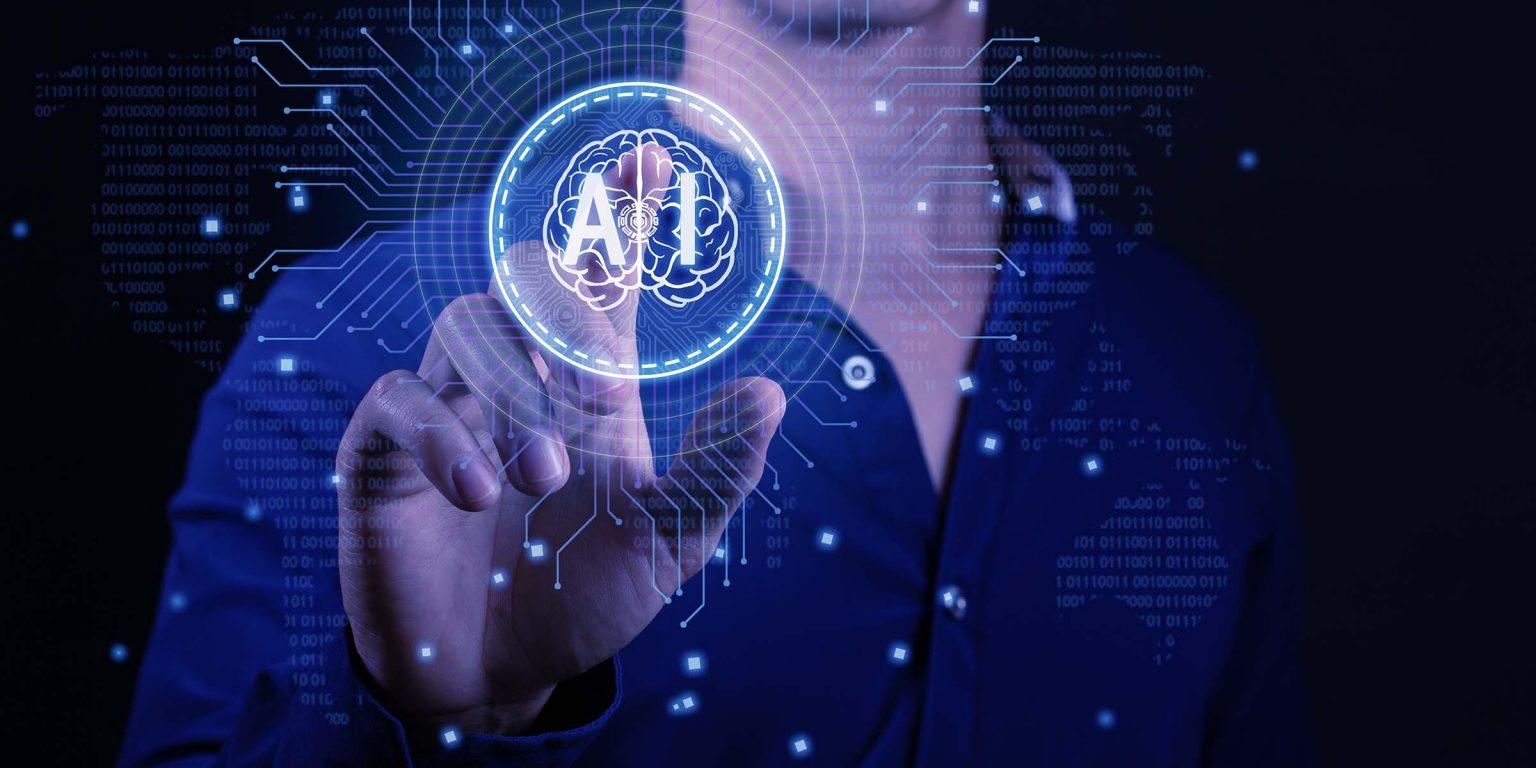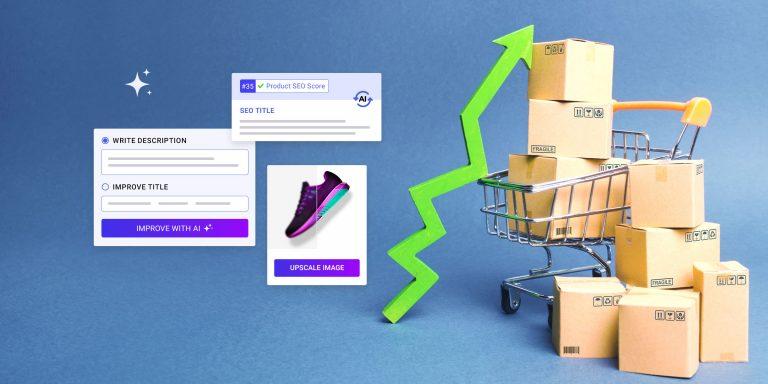The dropshipping and ecommerce market has become increasingly saturated, and staying ahead of the competition now requires even more innovative approaches. Enter Artificial Intelligence (AI) – a game-changer that is revolutionizing the dropshipping landscape.
So, let’s see how AI is transforming dropshipping, enhancing efficiency, improving customer experience, and driving business growth.
Table of Contents
The impact of the pandemic on ecommerce
Since the start of the pandemic, online shopping in the US has increased 55%, reaching $1.7 trillion. And even now, once the pandemic has ended, it doesn’t seem to slow down.
Gartner forecasted that artificial intelligence (AI) software revenue worldwide will increase from $124 billion in 2022 to $297 billion in 2027. As such, we believe that online retailers, even smaller ecommerce companies, serious about keeping on top of their competitors need to integrate AI technologies and upgrade their ecommerce website functionality.
The power of AI in dropshipping
Artificial Intelligence, once the realm of science fiction, is now an integral part of modern business strategies. Its ability to analyze vast amounts of data, predict trends, and automate processes makes it an invaluable tool for dropshippers. But how exactly is AI changing the game? Let’s explore.
1. Enhanced product research and selection
One of the biggest challenges in dropshipping is selecting the right products to sell. AI-powered tools can analyze market trends, consumer behavior, and competitor strategies to identify profitable niches and products. These tools can sift through millions of data points to highlight products with high demand and low competition, giving dropshippers a significant edge.
For instance, AI can monitor social media trends and ecommerce platforms to spot emerging products before they become mainstream. This proactive approach allows dropshippers to stay ahead of the curve and capitalize on new opportunities.
2. Personalized customer experience
In the age of personalization, customers expect tailored shopping experiences. AI enables dropshippers to deliver just that. By analyzing customer data, AI can provide personalized product recommendations, targeted marketing campaigns, and customized offers.
For example, AI algorithms can track a customer’s browsing and purchasing history to suggest products they are likely to buy. This level of personalization not only enhances the customer experience but also boosts conversion rates and customer loyalty.
3. Efficient inventory management
Inventory management is a critical aspect of dropshipping. Overstocking or understocking can lead to lost sales and increased costs. AI-powered inventory management systems can predict demand accurately, ensuring optimal stock levels.
These systems use historical sales data, seasonal trends, and market conditions to forecast demand. By automating inventory management, dropshippers can reduce human errors, minimize storage costs, and ensure timely fulfillment of orders.
4. Optimized pricing strategies
Pricing can make or break a dropshipping business. AI-driven pricing tools analyze market conditions, competitor pricing, and customer demand to recommend optimal pricing strategies. These tools can dynamically adjust prices in real-time to maximize profits and remain competitive.
For instance, if a competitor lowers their prices, AI can instantly adjust your prices to ensure you remain competitive. Conversely, if demand for a product surges, AI can increase prices to capitalize on the higher demand.
5. Streamlined order fulfillment
Efficient order fulfillment is crucial for customer satisfaction. AI can streamline the fulfillment process by automating order processing, tracking shipments, and managing returns. AI-powered chatbots can handle customer inquiries about order status, delivery times, and returns, providing instant support and reducing the burden on customer service teams.
Additionally, AI can optimize shipping routes and methods to ensure timely and cost-effective deliveries. By minimizing delivery times and costs, dropshippers can enhance customer satisfaction and reduce operational expenses.
6. Advanced fraud detection
Fraud is a significant concern in ecommerce. AI can help mitigate this risk by detecting fraudulent activities in real-time. AI algorithms can analyze transaction patterns, identify anomalies, and flag suspicious activities.
For example, if a transaction deviates from typical purchasing behavior, AI can alert the dropshipper to investigate further. This proactive approach helps prevent fraud and protects both the business and its customers.
7. Data-driven marketing
Marketing is essential for attracting and retaining customers. AI can revolutionize marketing strategies by providing data-driven insights and automating campaigns. AI-powered tools can analyze customer behavior, segment audiences, and create personalized marketing messages.
For instance, AI can determine the best times to send marketing emails, the type of content that resonates with different customer segments, and the optimal channels for reaching target audiences. This precision in marketing can lead to higher engagement rates and better return on investment (ROI).

Real-world applications of AI in dropshipping and ecommerce
Let’s take a look at some real-world examples of how AI is being used in dropshipping to achieve remarkable results.
1. Anker
A notable example of AI’s impact on dropshipping is the case of Anker, a consumer electronics brand. Anker utilized AI algorithms to analyze customer feedback and purchasing patterns, allowing them to optimize their product offerings and marketing strategies.
By implementing AI-driven demand forecasting, they reduced inventory costs by 20% and increased sales by 30% within a year. Their personalized marketing campaigns, powered by AI insights, led to a significant boost in customer engagement and repeat purchases.
2. Amazon
Amazon employs AI across its vast ecommerce ecosystem to enhance customer experience, optimize logistics, and streamline operations. AI algorithms power their recommendation engine, which suggests products to customers based on their browsing and purchase history. Amazon’s AI also manages inventory, predicting demand and optimizing stock levels across its fulfillment centers. Moreover, Amazon’s AI-driven chatbots provide customer support, handling queries and resolving issues efficiently.
3. Walmart
Walmart uses AI to optimize its supply chain and improve inventory management. AI-powered systems analyze sales data, market trends, and external factors to forecast demand accurately. This helps Walmart maintain optimal stock levels and reduce excess inventory.
Additionally, Walmart employs AI to enhance its online shopping experience, providing personalized recommendations and targeted marketing campaigns.
Revolutionize your store with AppScenic AI-powered features
AppScenic is now more than an automation dropshipping platform that handles inventory management, pricing, and order fulfillment. Our leverages AI to streamline operations and enhance efficiency. These next AI-driven tools help dropshippers stay competitive and grow their businesses.
Improved titles and descriptions
You now have ability to create perfect product titles and descriptions that not only catch the eye but also convert users. With AppScenic’s new AI-powered tool, you can create compelling and high-converting product titles and descriptions effortlessly.
Visually stunning images
AppScenic’s Image Upscaling feature can enhance your images up to 4 times their original resolution. No more blurry, low-quality images, only captivating visuals that grab attention.
Ecommerce SEO optimization
Optimizing your online store for SEO can be a complex task. But our Ecommerce SEO Optimization AI tool takes the hassle out of optimizing your products for SEO, handling everything from titles and descriptions to generating crucial SEO data like keywords, search volumes, and trends.
Advertising and social media AI tool
Using the power of AI and ChatGPT, this AI tool helps you generate ads tailored for Google, Facebook, and Instagram, optimizing your marketing efforts and boosting your conversion rates. With this feature, you can effortlessly create ad content for effective marketing campaigns that drive results in just a few clicks.
The future of AI in Dropshipping
The integration of AI in dropshipping is still in its early stages, but the potential is immense. As AI technology continues to evolve, we can expect even more sophisticated applications in the dropshipping industry.
Here are some future trends to watch.
1. AI-driven supply chain optimization
AI will play a crucial role in optimizing the entire supply chain, from sourcing products to delivering them to customers. AI algorithms will analyze data from various sources to predict demand, optimize inventory levels, and ensure timely deliveries.
2. Voice commerce
Voice commerce is on the rise, and AI will be at the forefront of this trend. AI-powered voice assistants like Amazon’s Alexa and Google Assistant will enable customers to place orders using voice commands. Dropshippers will need to optimize their stores for voice search to stay competitive.
3. Enhanced customer support
AI-driven chatbots will become more advanced, providing even more accurate and personalized customer support. These chatbots will be able to handle complex inquiries, resolve issues, and provide a seamless customer experience.
4. Predictive analytics
Predictive analytics will become a game-changer for dropshippers. AI will analyze past data to predict future trends, allowing dropshippers to make proactive decisions. From forecasting demand to identifying potential market shifts, predictive analytics will provide valuable insights.
Conclusion
AI is transforming the dropshipping industry, offering unprecedented opportunities for efficiency, personalization, and growth. By leveraging AI-powered tools, dropshippers can enhance their product selection, optimize pricing, streamline order fulfillment, and deliver personalized customer experiences.
As AI technology continues to advance, the dropshipping industry will continue to evolve, presenting new possibilities and challenges. Embracing AI is not just an option; it’s a must to stay competitive in the dynamic world of dropshipping.
Read next: The Future of Dropshipping Automation: What’s Next?











